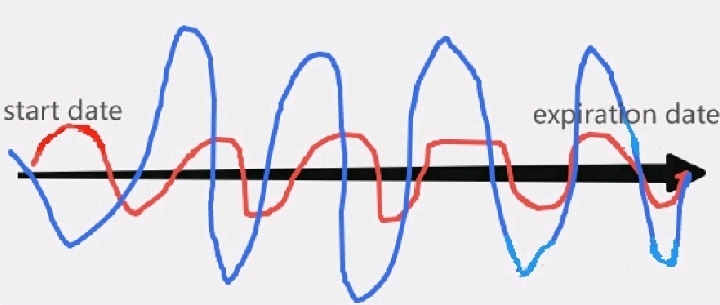Understanding Implied Volatility (IV) with Common Sense
Alright, so I'm trying to wrap my head around how IV (Implied Volatility) and option prices are connected to help me out in my trading game.
Here's my notes below – i hope they're helpful.
1. What Makes Option Prices Tick
First off, we've got the Black-Scholes model, the big cheese in the option pricing world. It's got six main ingredients:
First off, we've got the Black-Scholes model, the big cheese in the option pricing world. It's got six main ingredients:
① Strike Price: That's the price agreed upon in the option contract for buying or selling the asset.
② Time to Maturity: Basically, how much time's left before the option expires.
③ Risk-free Rate: The sweet deal you can get without breaking a sweat, usually based on short-term government bonds.
④ Dividends: If the stock's dishing out dividends before the option expires, it's gonna affect the option's value 'cause the option holder won't get those payouts.
⑤ Underlying Price: The going rate for the asset in the market.
⑥ Implied Volatility (IV): This one's a bit trickier – it's what the market reckons the asset's price swings will look like.
Now, here's the kicker – Besides implied volatility, all the other five factors are actual, tangible values.
Implied volatility, on the other hand, is derived using an options pricing model like Black-Scholes, based on the actual trading prices of options in the market (considered as theoretical prices) and other known factors such as the strike price, time to maturity, risk-free rate, dividends, and current stock price.
2. How IV Shakes Things Up for Options
Buckle up 'cause here's the deal – more volatility means higher option prices. So, let's lock in those other five factors we talked about and see how different volatility levels affect option prices for two stocks: Tesla $Tesla(TSLA.US$ and Qualcomm $Qualcomm(QCOM.US$, both with options expiring this month and a strike price of 170.
Their stock prices are pretty close, give or take a buck.
But here's the kicker – Tesla's option is going for $735, while Qualcomm's is at $580.
Tesla's got an IV of about 48%, while Qualcomm's sitting at around 30%.
Long story short – higher volatility equals pricier options.
Now, remember how I said IV's all about what the market thinks the future price swings will be? Well, higher IV means folks are expecting bigger moves down the road. Tesla's IV is higher than Qualcomm's, which means Tesla's expected to be bouncing around more.
Now, imagine the path from now till option expiry day for Tesla (shown in blue) and Qualcomm (in red), like in this chart.

Let's say you snag one call option each for Tesla and Qualcomm with a strike price of 170 expiring this month. Wouldn't Tesla's option potentially bag you a bigger win 'cause it's got more room to shoot up? So, for the same call, being almost twice as pricey for Tesla, it makes sense to sell it to you for a bit more moolah.
This golden rule applies whether the option's in or out of the money.
Higher IV also means a bigger chance of things going south. When you're buying options, the worst-case scenario is losing everything you forked out, landing you a -100% return.
Some traders steer clear of high IV options 'cause it usually means there's a frenzy in the market (think blockchain stocks), making it easy for big players (the pros) to take your premium and run.
3. Riding the IV Rollercoaster
Now, how do you play the IV game? Easy – when IV's low, you wanna jump in and buy those call options. Then, when IV's high, cash out and call it a day.
Now, how do you play the IV game? Easy – when IV's low, you wanna jump in and buy those call options. Then, when IV's high, cash out and call it a day.
If you're into Delta Neutral, that's cool too. It's all about tweaking your option portfolio so it's not too bothered by changes in the stock's price (we're talking Delta values close to 0). That way, you can focus on riding the IV wave for profits instead of worrying about the stock price itself.
The trick to making bank with high IV is making sure your gains from IV hikes outweigh the losses from time decay.
Shorting IV means selling options when their prices are high. You can do this by shorting calls, shorting puts, or doing both simultaneously.
However, when it comes to highly volatile stocks, naked option selling isn't advisable. It ties up a lot of capital, carries high risks, and is better suited for experienced traders.
In my understanding, as an options seller, you need to be prepared to take on and offload positions strategically.
For instance, employing a covered call strategy, which involves holding the underlying stock while shorting calls, indicates your intention to take profits and exit.
Alternatively, using a cash-secured put involves setting aside cash to cover the potential purchase of stocks at a specific price—a strategy for waiting to enter the market at a favorable price.
Disclaimer: Community is offered by Moomoo Technologies Inc. and is for educational purposes only.
Read more
Comment
Sign in to post a comment

EnjoyTheProcess : I find your posts about options trading immensely useful in helping me formulate my own options trading strategy. Do u have your own group chat? And in case u r wondering, no, it doesn't have anything to do with ur display pic. From the way u write, i know u r a dude
BelleWeather : This was essentially what I was going to post! Volatility and Time must be optimized, then the strike price, depending on one’s goals.